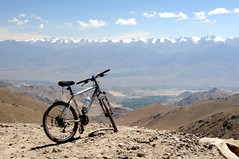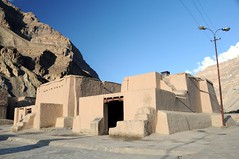We threw our burden onto the gravel heap in the trailer and climbed up onto a back tray between the wheels of the tractor and happily bounced the last four kilometres into town. It was a great relief to know there was no more trudging along the dusty boring road with our full packs.
This was the Spiti valley, another slice of Tibetan moonscape (or perhaps Marscape) in the far north of India. We had been hiking the 16km back to the main town in the valley because the public bus system in Spiti is unfortunately a little erratic. The only other way around is to hire jeeps and the local taxi union (mafia) sets exorbitant prices for foreigners.
So we walked back to Spiti's capital, Kaza, and notched up a new mode of transport that we had not ridden before: a tractor ride. And even though it was very bumpy and we had to hold on for dear life, it was certainly more sedate than the other main mode of transport over the last couple of weeks: the bus. Buses have either been long, frustrating, painful or terrifying.
But back to Ladakh, which seems like a long time ago now. We got there on that long bus ride as described before and stayed a week in the isolated Buddhist (former) kingdom, soaking up the comforts and sights that this entailed. Leh in parts was a complete tourist town, in fact in the area we stayed, Changspa, you could call it little Israel. Hebrew was outspeaking any other foreign language 2 to 1. But being touristy it was still surprisingly fantastic. Leh has to rate as one of my most favourite towns.
The reason we enjoyed the place and why it lived up to my expectations was due to its setting. Surrounded by moonscape, Leh was an oasis of green fed by irrigation channels flowing with feng shui goodness. The small town centre bustled at just the right pace but it only took a few minutes to walk off through the stone-walled alleys into semi-rural surroundings. The old palace and Gompa (monastery) loomed over the town on one side and was pleasantly twinned by a new, Japanese built stupa on the other side of town, the place to go for sunsets.
We filled our time in the Ladakhi capital by munching our way through the smorgasbord of delights which competed for our rupee. There was also the chance to ride a mountain bike down from the highest motorable pass in the world (supposedly 5600m, but my GPS, and others, had it at around 5380m – still bloody high). You get a two hour lift up to the frosty top 39km away from Leh, have a cup of chai trying to negate some of the altitude sickness and then ride on down for the next three hours.

My bike for the ride
But the fun and relaxation of Leh had to end and then it was to the painful trip of getting back from Ladakh. It was basically backtracking via the route we had already taken to get there (the only other overland route from Ladakh is through Kashmir, and even though I would like to go there have been some major flare ups recently and is just too dangerous). This time though instead of a long haul sleep deprived van trip we decided to take the "deluxe" government bus to the first real settlement south of Leh, Keylong in the Lahaul valley.
Fortunately the government bus was a lot slower than the van, unfortunately that meant that it took 15 hours for a journey around 350km starting at 5 in the morning. We also had to put up with getting the last two seats on the bus in the back row. Normally I like being a back seat heavy, but in this case it meant that concussion almost occurred numerous times as we were launched airborne over bumps into the luggage rack above us. There was also a non-working fan strategically placed with its sharp metal edge right next to your head. Any time a bump was felt coming it was duck and cover.
Arriving very weary in the pitch black in Keylong, it was with great relief to not only depart the bus but find a fantastic cheap guesthouse with for the first time a TV actually showing the Olympics (the second to last day of competition). We caught our first views of the competition, which turned out to be a gymnastic version of synchronised swimming with five girls but with ropes and hoops. Is this new?
The guesthouse kudos was increased tenthfold upon morning when we looked out the window and discovered a bunch of white snow capped peaks of over 6000m bearing down us at the end of a green, steep V shaped valley. You have to love the Himalayas; views you just don't get back home.
The other poor saps from our bus trip left brazenly early on the same deluxe torture and carried on south to our previous departure point, Manali. We instead stayed along with another Australian couple and their four year old son and enjoyed a proper stop over break by exploring the surrounding area. This involved a hike across the valley to a traditional village called Khardung.
With stone walled houses built over mucked up stables, roofs piled high with winter fodder and drying dung for fuel, the village obviously hadn't changed much in centuries. We further ventured (or slogged) up the steep valley slope to a Buddhist Gompa (monastery) which unfortunately we didn't even get to see inside as no monks were to be found.
The next day we teamed up with the friendly Aussies (it was great to converse about things back home – it had been a while) and gave the buses a miss altogether, paid the extra to hire a jeep taxi. It just so happens they were heading the same direction as us, the 10 hour trip to the adjacent – dusty again - Spiti Valley.
The Himalayas shield the valley and the ones north, like Ladakh and Tibet, from the monsoon. Which is precisely why we were here, to escape the rain. The effect though is the dusty, Mars like landscape it creates. It is a cold desert, but healthily inhabited by hearty friendly folk.
The valley like its neighbours is predominately Buddhist, which means there are some amazingly old Gompas to visit. One in particular at the village of Tabo is World Heritage listed for its amazing 1000 year old murals littering its dark interior. We got a personal tour with a monk and our Australian friends and it was hard to believe that we were so close to something created so long long ago. I felt like Indiana Jones with my torch in hand examining the fine detail inside a mud built temple that looked like those mosques in Mali.

Tabo Gompa
Unfortunately the frustrating and scary Spiti bus network let the valley down. It was a tad bizarre and incurred my wrath as we waited and waited in the dusty capital Kaza for the bus to the village of Kibber. Instead of a logical small bus that shuttles back and forth a few times a day between the population centres, there is a only a single bus which originates about 100km away down the valley. It is usually scheduled to get to Kaza around 5:30pm but by the time it got there for us it was over two hours late. Hence why we were walking and taking tractors back to Kaza.
And then finally there is the scary and terrifying aspect of the bus system which we discovered as we were heading on south out of the valley: maniac drivers. In a valley full of hair-pin turns and blind corners we managed to get a driver that ignored it all and went full throttle the whole way. At one point one of our friendly tractor and trailer combos filled with people was nearly collected and sent into the rushing Spiti river below. We held on for dear white knuckled life.
To make the journey just that tad more exciting, the road had been made impassable for the bus due to a landslip. We were forced to strap on the packs and clamber over loose rock to where the road began again and board another bus. The drop into the valley below meant that a cup of chai was required to calm the nerves when we reached our destination nearby.
Now we are making a big loop back to Shimla. We have left the dusty valleys behind and are back in the greenery of the Kinnaur Valley to the south. We have a week to get back to Delhi before we head off again to another new country, but with just as many mountains – if not more - than the Indian north. Tidings from there.
No comments:
Post a Comment